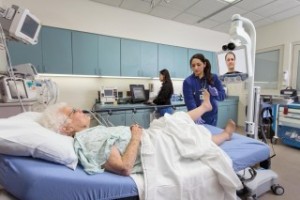Mar 25 2014
When the clock starts ticking after the onset of stroke symptoms, access to a neurologist is crucial. Quickly diagnosing a stroke allows for the administration of lifesaving tPA (tissue plasminogen activator) in patients who quality for this treatment. tPA is a clot busting drug that can restore blood flow to the brain; if given to the patient within three to four hours of the onset of a stroke, tPA can improve the chances of recovering from a stroke.
 Neuro-hospitalist communications with emergency department physician through telemedicine. Source: Baylor Health Care System
Neuro-hospitalist communications with emergency department physician through telemedicine. Source: Baylor Health Care System
Baylor Health Care System is bringing advanced neurologic stroke expertise to its community-based medical centers via a portable robot communication system or telemedicine.
“This telemedicine system allows a neurologist to look at, talk to and examine the patient, and help make treatment decisions,” said Dion Graybeal, M.D., medical director for Baylor Health Care System’s hub-and- spoke stroke program.
Neuro-hospitalists based at Baylor University Medical Center in Dallas use IPads or laptop computers to connect with other Baylor medical centers whenever a call comes from their emergency departments. Currently Baylor Medical Centers at Irving, Garland, Waxahachie, Baylor Regional Medical Center at Plano, and Baylor All Saints Medical Center at Fort Worth utilize the hub-and-spoke stroke program.
Roll in the neurologist
For Judy Buck, the neurologist’s virtual presence in the emergency department helped save her life. She arrived at Baylor Medical Center at Irving after experiencing a sudden heaviness in her left side. The emergency physician ran tests and then rolled in the neurologist via the portable robot communication system.
Telemedicine Speeds Stroke Diagnosis
Buck was impressed.
“It was like the doctor was standing right there,” she said. “It was like science fiction.”
Time is brain
Dr. Graybeal and the Baylor Irving emergency department physician determined that Buck was having a stroke, and lifesaving tPA (tissue plasminogen activator) was begun.
“Unfortunately with stroke, time is brain,” said Dr. Graybeal. “About 1.9 million neurons are lost with every minute of lack of blood flow.”
Fortunately for Buck, from the onset of her symptoms to treatment time was just 90 minutes.
Know the signs
Buck had to relearn many basic skills following the stroke; she was home in ten days and back to work in three months.
“I am on a campaign to tell people how important it is to know the symptoms of stroke,” said Buck.
The American Stroke Association recommends F.A.S.T. as an acronym to remember the sudden signs of stroke:
Face drooping
Arm weakness
Speech difficulty
Time to call 9-1-1
Buck recognized that something was wrong and was lucky that her husband could take her to the hospital.
“I thank God every day that my husband took me to the hospital so quickly and that Baylor had such incredible technology to help save me,” she said.
About Baylor Scott & White Health
Baylor Health Care System and Scott & White Healthcare merged their two systems in 2013 thereby creating the largest not-for-profit health care system in the State of Texas with 43 hospitals, more than 500 patient care sites, more than 6,000 affiliated physicians, 34,000 total employees and the Scott & White Health Plan. Baylor Scott & White Health is a not-for-profit health care system with total assets of $8.3 billion* and the vision and resources to offer its patients continued quality care while creating a model system for a dramatically changing health care environment.
www.BaylorScottandWhite.com
Physicians are members of the medical staff at one of Baylor Health Care System’s subsidiary, community or affiliated medical centers and are neither employees nor agents of those medical centers, Baylor University Medical Center at Dallas or Baylor Health Care System.